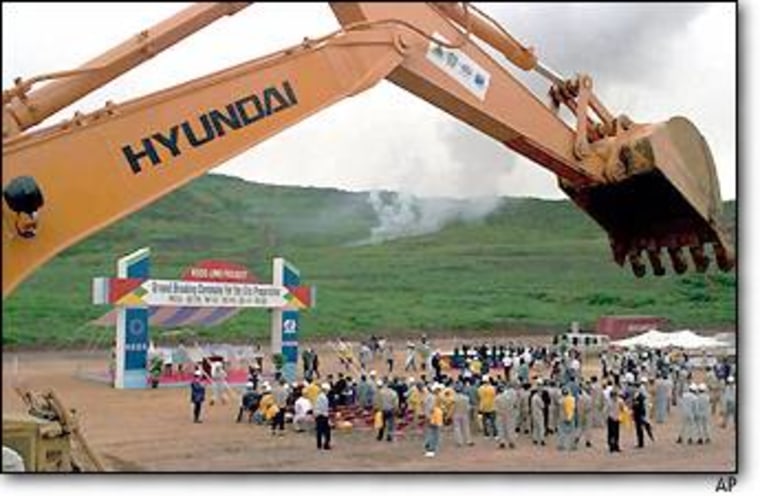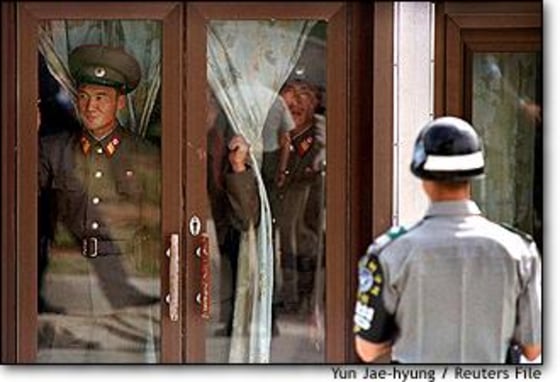The United States, South Korea and Japan expect to announce an agreement later this week ending a financial dispute that had threatened to scuttle the controversial 1994 North Korea nuclear non-proliferation pact, according to a U.S. source close to the project.
ONGOING TALKS between the three allies under the auspices of the Korean Energy Development Organization or KEDO, the consortium created to build the new plant, have produced an agreement to go ahead with funding for the project without settling the question of a $300 million-to-$400-million shortfall in the project’s final price tag of about $4.6 billion.
“We have made very significant progress in discussions on this over the last several months and will be able to announce a solution very soon,” said the source, who requested anonymity. KEDO’s board, with representatives from the United States, Japan and both Koreas, meets again Friday in New York City. The source indicated the agreement would be finalized at that meeting.
A State Department official also familiar with the talks refused to speculate on the deal, only saying that “the U.S. has not indicated any willingness at this point to seek or provide additional funds” to meet the shortfall.
A western diplomat in Seoul, again anonymously, added: “They have agreed not to think about this bridge until they cross it.”
THE TROUBLE WITH MONEY
Disputes over how to finance the liquid-fuel nuclear reactor — which produces far less weapons-grade plutonium than the older Soviet models — have plagued the so-called Agreed Framework pact from the start. Under the pact, North Korea agreed to halt its well-established nuclear weapons development program and shut down its proliferation-prone Soviet-designed nuclear reactors. The United States, in exchange, pledged to champion, but not pay for, the construction of two light water reactors. Payment would be the responsibility of North Korea’s Asian neighbors.
Most of the costs have been carried by South Korea (70 percent) and Japan (about 20 percent). The only American commitment for the politically unpopular deal was to supply 500,000 tons of heavy fuel to North Korea each year — at an annual cost of from $30 million to $50 million — until the reactors came online sometime in the first decade of the next century. Congress has reluctantly appropriated those funds every year since the deal went into effect in 1994.
On Wednesday, Rust Deming, U.S. deputy assistant secretary of state, told a Senate Foreign Relations subcommittee hearing on the subject that “we are committed to redoubling our efforts to gain support from other countries, but frankly it is not realistic to think that the shortfall will be met in the near term by contributions from abroad.”
Deming urged continued U.S. leadership in the program, saying it “is a small price to pay to reinforce peace on the Korean Peninsula and to strengthen the global non-proliferation regime.”
But U.S. officials who hoped the other 10 percent might be picked up by nervous locals — Asian tigers like Singapore, Thailand or even China — were overly optimistic. Neither Asia’s now-tamed tigers nor far off Europe ponied up. That means a shortfall of $300 million or more.
HOLDING THE BAG?
All of this left the Koreans, North and South, feeling rather exposed.
The North, which admitted to diverting weapons-grade plutonium from its program prior to the pact in a bomb-making effort, also has accepted inspectors from the International Atomic Energy Agency at the shuttered Yongbyon plant and six other declared nuclear sites. Increasingly this year,

Pyongyang has complained about the slow pace of the U.S. fuel shipments and what it sees as slow progress at the site of the new plant in Kumho, where ground was broken by the South Korean contractors last spring.
Increasingly, Korean analysts say, the North appeared to be questioning whether the financial dispute between its partners was part of a plan to scuttle the reactor deal after having obtained a freeze on the North’s nuclear program. At the very least, the North seems skeptical that financing will be resolved.
James Kelly, the director of Asian affairs in the Reagan White House and now president of the Pacific Forum, doesn’t think that’s so crazy.
“I think that, like a number of institutions in Asia, KEDO is real until someone comes along and gives it a small push, then it falls over,” he said. “I think the North is concerned that the momentum of this thing has been lost. And frankly I can’t see who’s going to pick up the $4.6 billion bill over the long term.”
In the South, concerns are slightly different. From the beginning of the U.S. talks with North Korea, Seoul complained it was being left out of the process.
“For the South Koreans, this is basically taxation without representation,” said Scott Snyder, Asian affairs analyst at the U.S. Institute for Peace. “They are firm in their commitment to pay 70 percent of the costs. But they can add and they want to know where the rest of it is coming from.”
NORTHERN EXPOSURE
Meanwhile, back in Washington, the question of North Korea’s ability to restart its nuclear program should it choose to renounce the deal is under discussion. A month ago, after several delayed fuel deliveries and unsatisfactory assessments of construction project, the North announced ominously that it was re-entering the old Soviet-designed reactor complex at Yongbyon to “renew maintenance on reprocessing,” a clear warning from Pyongyang.
Back in late 1993, the Yongbyon reactor stirred such controversy that two American carriers headed to Korean waters and “the Korea nuclear scare” briefly bumped the furor de jour, gays in the military, off the better talk shows (very briefly). On one of them, Lawrence Eagleburger, the last secretary of state of the ousted Bush administration, even suggested bombing the Yongbyon plant.
What set Eagleburger and many in the military establishment ticking was North Korea’s decision to drop out of the nuclear non-proliferation convention and subsequent CIA-leaked intelligence suggesting the North may have built a crude weapon. That allegation continues to be debated but this much is certain: IAEA inspectors with access to the North Korean sites say several kilograms of highly-enriched uranium is unaccounted for. In U.S. hands, three or four nuclear weapons could be fashioned from that; in less sophisticated hands, perhaps (but not certainly) one crude weapon.
North Korea’s decision in June to “renew maintenance on reprocessing” went largely unremarked in the United States. The State Department noted that IAEA inspectors accompanied the North Koreans into the plant and that “they did nothing they’re not entitled to under the Agreed Framework.”
Indeed, many question whether North Korea, flat on its back economically and without friends in the world, will risk the deal it managed to strike for the sake of a nuclear program it can’t afford.
Kelly, remembering his dealings with the Korean question in the Reagan years, largely agreed. “They have this dilemma — they want to survive,” he said. “Their nuclear weapons are not realistically a military option. Experience suggests that they’re hard to work with but they’re not crazy.”
Michael Moran is MSNBC’s international editor.
